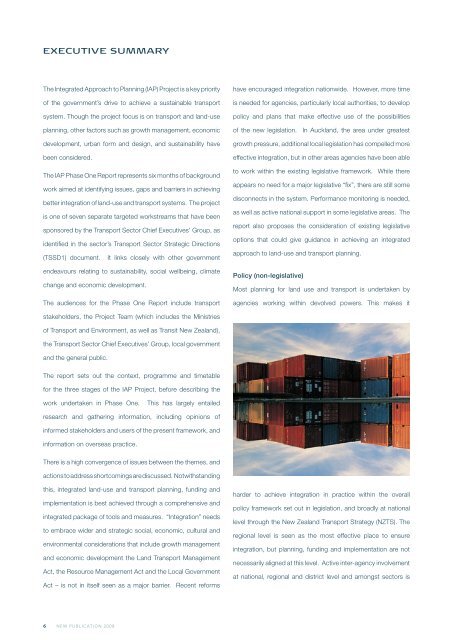improved intergration of land use and transport - NZ Transport Agency
improved intergration of land use and transport - NZ Transport Agency
improved intergration of land use and transport - NZ Transport Agency
You also want an ePaper? Increase the reach of your titles
YUMPU automatically turns print PDFs into web optimized ePapers that Google loves.
EXECUTIVE SUMMARY<br />
The Integrated Approach to Planning (IAP) Project is a key priority<br />
<strong>of</strong> the government’s drive to achieve a sustainable <strong>transport</strong><br />
system. Though the project focus is on <strong>transport</strong> <strong>and</strong> <strong>l<strong>and</strong></strong>-<strong>use</strong><br />
planning, other factors such as growth management, economic<br />
development, urban form <strong>and</strong> design, <strong>and</strong> sustainability have<br />
been considered.<br />
The IAP Phase One Report represents six months <strong>of</strong> background<br />
work aimed at identifying issues, gaps <strong>and</strong> barriers in achieving<br />
better integration <strong>of</strong> <strong>l<strong>and</strong></strong>-<strong>use</strong> <strong>and</strong> <strong>transport</strong> systems. The project<br />
is one <strong>of</strong> seven separate targeted workstreams that have been<br />
sponsored by the <strong>Transport</strong> Sector Chief Executives’ Group, as<br />
identified in the sector’s <strong>Transport</strong> Sector Strategic Directions<br />
(TSSD1) document. It links closely with other government<br />
endeavours relating to sustainability, social wellbeing, climate<br />
change <strong>and</strong> economic development.<br />
The audiences for the Phase One Report include <strong>transport</strong><br />
have encouraged integration nationwide. However, more time<br />
is needed for agencies, particularly local authorities, to develop<br />
policy <strong>and</strong> plans that make effective <strong>use</strong> <strong>of</strong> the possibilities<br />
<strong>of</strong> the new legislation. In Auck<strong>l<strong>and</strong></strong>, the area under greatest<br />
growth pressure, additional local legislation has compelled more<br />
effective integration, but in other areas agencies have been able<br />
to work within the existing legislative framework. While there<br />
appears no need for a major legislative “fix”, there are still some<br />
disconnects in the system. Performance monitoring is needed,<br />
as well as active national support in some legislative areas. The<br />
report also proposes the consideration <strong>of</strong> existing legislative<br />
options that could give guidance in achieving an integrated<br />
approach to <strong>l<strong>and</strong></strong>-<strong>use</strong> <strong>and</strong> <strong>transport</strong> planning.<br />
Policy (non-legislative)<br />
Most planning for <strong>l<strong>and</strong></strong> <strong>use</strong> <strong>and</strong> <strong>transport</strong> is undertaken by<br />
agencies working within devolved powers. This makes it<br />
stakeholders, the Project Team (which includes the Ministries<br />
<strong>of</strong> <strong>Transport</strong> <strong>and</strong> Environment, as well as Transit New Zea<strong>l<strong>and</strong></strong>),<br />
the <strong>Transport</strong> Sector Chief Executives’ Group, local government<br />
<strong>and</strong> the general public.<br />
The report sets out the context, programme <strong>and</strong> timetable<br />
for the three stages <strong>of</strong> the IAP Project, before describing the<br />
work undertaken in Phase One.<br />
This has largely entailed<br />
research <strong>and</strong> gathering information, including opinions <strong>of</strong><br />
informed stakeholders <strong>and</strong> <strong>use</strong>rs <strong>of</strong> the present framework, <strong>and</strong><br />
information on overseas practice.<br />
There is a high convergence <strong>of</strong> issues between the themes, <strong>and</strong><br />
actions to address shortcomings are discussed. Notwithst<strong>and</strong>ing<br />
this, integrated <strong>l<strong>and</strong></strong>-<strong>use</strong> <strong>and</strong> <strong>transport</strong> planning, funding <strong>and</strong><br />
implementation is best achieved through a comprehensive <strong>and</strong><br />
integrated package <strong>of</strong> tools <strong>and</strong> measures. “Integration” needs<br />
to embrace wider <strong>and</strong> strategic social, economic, cultural <strong>and</strong><br />
environmental considerations that include growth management<br />
<strong>and</strong> economic development the L<strong>and</strong> <strong>Transport</strong> Management<br />
Act, the Resource Management Act <strong>and</strong> the Local Government<br />
Act – is not in itself seen as a major barrier. Recent reforms<br />
harder to achieve integration in practice within the overall<br />
policy framework set out in legislation, <strong>and</strong> broadly at national<br />
level through the New Zea<strong>l<strong>and</strong></strong> <strong>Transport</strong> Strategy (<strong>NZ</strong>TS). The<br />
regional level is seen as the most effective place to ensure<br />
integration, but planning, funding <strong>and</strong> implementation are not<br />
necessarily aligned at this level. Active inter-agency involvement<br />
at national, regional <strong>and</strong> district level <strong>and</strong> amongst sectors is<br />
N E W P U B L I C AT I O N 2 0 0 8

















